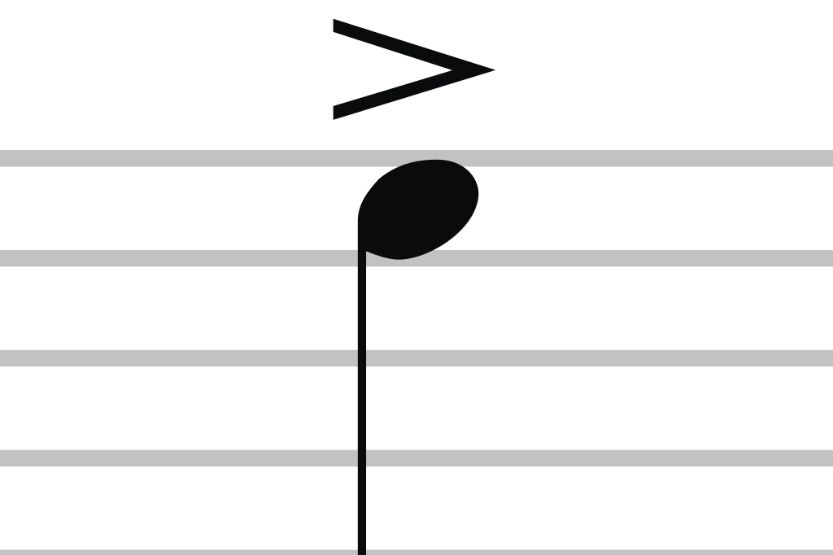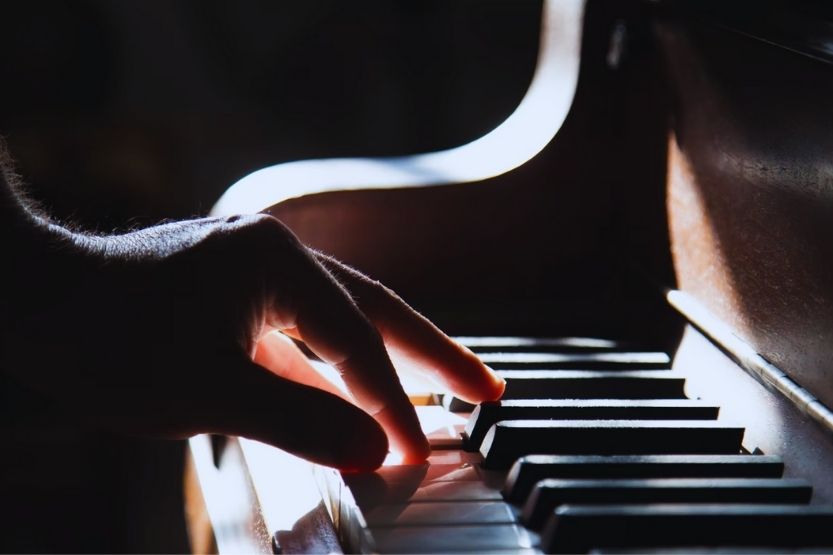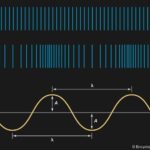Musicians use musical note indications to determine how they should play a certain note or group of notes. One of these indications or signs is marcato. In this article, I’ll show you what marcato means in music.
Marcato is a direction to the singer or instrumentalist to play the note or set of notes with strong accentuation. Usually, there is an indication or a sign above the note or group of notes. The sign is in the form of an open vertical wedge-shaped mark customarily placed at the top of the note.
The word ‘marcato’ was taken from an Italian word that means “hammered.” That will already give you a hint of how the note with this sign should be played. If this mark is found on a note or set of notes, the sound should be emphasized. It should also be for a short duration only, like a staccato note.
Read on to learn more about the meaning of marcato in music, how it is expressed and how it should be written.
Marcato – Music Definition

Direction on Playing Notes
In music, marcato is used as a direction on playing a note or a group of notes. This word is generally understood to mean the note or notes should be played with strong accentuation. The direction is always written as a sign or mark, usually an open vertical wedge-shaped mark. It is typically written above the note or set of notes.
Origin of the Word ‘Marcato’
The word ‘marcato’ was taken from an Italian word that means ‘hammered.’ This will already give you an indication of how a note with this mark should be sung or played. The note should be stressed or emphasized. Another meaning of this word is that the note should be played like a staccato note.
Should Be Played for a Short Duration
That means the note should also be played for a short duration only. So, to complete its basic meaning marcato is a direction to the instrumentalist or vocalist to stress the note or emphasize it. And they should play the note in a staccato way or with a sense of urgency.
Short-held Note
Marcato indicates a short-held note as opposed to legato, which is a long-held note. It also means the notes should be played a bit louder than the rest of the un-marked notes. Marcato also means to play the note or notes more forcefully.
Louder Version of a Regular Accent
It is essentially a louder version of the regular accent. This is why many are confusing marcato with an accent. But the direction for accent is an open horizontal wedge, while the direction for marcato is an open vertical wedge.
History and Etymology of Marcato
Many centuries ago, composers were thinking of ways on how they could notate their music with precision. For instance, JS Bach made certain articulation, phrasing, and dynamics to his musical compositions. But he left most of the decisions to the usual ways the musicians of his day interpreted his written music.
This situation changed during the 20th century going up to the present. Composers no longer allowed musicians to interpret their music their way. Unlike JS Bach, modern composers like Brian Ferneyhough have notated his music with all the intricate directions he wanted the musicians to follow.
One of these intricate directions is marcato. It means the note or notes with this mark have to be played with strong accentuation. It seems that this mark had its start in 1840. The term was taken from an Italian word, ‘marcare,’ which means to mark or accent.
It is said that this word is of Germanic origin. They say it is somewhat similar to ‘marcon,’ an Old High German word meant to mark.
Period When Accent and Marcato Are Interchangeable
Music pieces come from different periods where an accent is used to indicate a marcato. There are times where marcato is used to indicate an accent. The same confusion is observed in different music genres. Many classical musicians may create a marcato note that is quite different from the marcato note of a Jazz music artist.
As it is, a marcato note should be played in an emphatic, accented, and stressed way if the Italian meaning is to be strictly followed. The musician plays each marcato note with a more forceful attack producing a much louder sound than any surrounding non-marcato notes.
More on Marcato’s Symbol and Meaning

Vertical Open Wedge Sign
To repeat, the vertical open wedge sign Λ means marcato, while the horizontal open wedge mark > means accent. Both marks direct the musician to give special treatment to the notes or notes that have their marks. But the treatment for marcato notes should be different from the treatment for accent notes.
Written Above or Below the Staff
Notes with the marcato sign should be played more forcefully or louder than the rest of the unmarked notes. On a music sheet, the word ‘marcato’ may be written above or below the staff. But most often, it may be indicated by the symbol Λ written above the note.
Essentially, marcato means a louder version of the standard accent. But like the regular accent, it is usually interpreted as a sharp attack that tapers off to the regular dynamic of the music piece.
It is applied to instruments that can alter the dynamic level of one sustained pitch. One author described it as a sound that indicates a rhythmic thrust swiftly followed by the muting of the sound.
Marcato’s Meaning in Jazz Band
In jazz band music, the marcato sign is typically meant as a note that should be shortened to about two-thirds of its normal duration, with a moderate only accent. For orchestral pieces, this sign may induce a string player to use martellato bowing, depending on the context of the music.
Again, what does marcato mean in music? Marcato is a musical sign or indication that a note or group of notes should be played loudly or with force. Its symbol is an open vertical wedge-shaped mark placed above a note.
Differences Between Marcato and Accent
For all types of music, whether vocal or instrumental, there are indications on how a note should be started or played in the music sheet. It tells the music player how the composer wants the music rendered about its dynamics.
Without the right knowledge of the difference between a marcato and an accent, many musicians are confused. Some believe that they are just the same. However, marcato and accent are different from each other:
1. Symbol
The most basic way to distinguish one from the other is their symbols. Marcato uses the symbol of the vertical open wedge, which looks like this: Λ. Accent uses the symbol of the horizontal open wedge, which is like this: >.
2. Degree of Accent
While the musician has to accent a note, the degree by which the accent is given is not the same. However, the confusion seems to still exist because of the inconsistent way musicians have used these two symbols.
So, if there are accents all over the place, how can you make some notes more noticeable? By doing a marcato on them. In other words, marcato is essentially an accent. But it is an accent that is louder and more pronounced than the standard accent.
3. Marcato Is Delivered More Forcefully
Just like an accented note, a marcato note should be delivered forcefully. However, the attack on the note should be more intense in the marcato than in the accent. This is a bit subjective, so the amount of force used depends on who plays the music.
4. Marcato Is Shorter in Duration
While generally, accents are given in shorter duration, marcato is delivered even shorter. In a way, this is just a natural result of playing the note more forcefully. It’s just like you are hitting the piano key with a reasonable force at the fastest time to produce the marcato effect.
That’s the only way to follow the directions in the music sheet if the whole piece is littered with accented notes.
5. Accent to Emphasize, Marcato to Cut Short
If you want to play a note with more emphasis, you should accent it in very basic terms. But if you want the sound to be forceful and strong, play it marcato, and cut it short. This is the general concept of music composers with regards to marcato and accent.
6. Marcato Can Be Played Differently In Different Instruments
The marcato articulation cannot be played exactly the same with different instruments. For instance, a piano player may not deliver the same marcato on a music piece the same way that a trumpet player or a piano player may deliver it using the same music piece.
Consequently, the temperament of the sound or the quality of sound that they will produce will not be exactly the same. In other words, the kind of instrument being used also influences the kind of marcato that a player can deliver.
How Do You Play Marcato

When a marcato symbol is imposed on a note in a music sheet, it means you need to give that note or set of notes the prominence that the composer wants them to have. Most often, the note will have a Λ symbol on top of it.
In his book “Evoking Sound: Fundamentals of Choral Conducting and Rehearsing,” James Mark Jordan writes that the sound of a marcato is described as “a rhythmic thrust followed by a decay of the sound.”
So, to produce a marcato note, you have to suddenly hit the note (if you are singing) or strike the note (if you are piano playing) according to the tempo and spirit of the music piece, and then suddenly cut off the sound.
How to Properly Indicate Marcato in a Music Piece
Music composers have different ways of indicating marcato notes in their compositions. There is a fancy way of doing it, and there is also a simple way it is done. The general idea is to indicate it with a vertical open wedge that looks like this: Λ. Simply put, it looks like an inverted V.
The marcato always faces upward in modern music sheets with its open base positioned directly on top of the note or the notehead. That means the open part of the inverted V is directly centered on the notehead.
The Λ is never and should never be written on the stem of the note. However, the stem of the note also influences how the Λ symbol is indicated. It should be written above the staff if the stem of the note is down and below the staff if the note’s stem is up.
Conclusion: Marcato – Music Definition
In music, marcato refers to the direction or instruction to the instrumentalist or vocalist to play the note or set of notes with strong accentuation. Typically, it is a sign or mark placed above the note or group of notes. The sign is in a vertical wedge-shaped mark usually placed at the top of the note.
Related reading:






![What Is Music Without Lyrics Called [and Popular Instrumentals] what is music without lyrics called](https://musicalinstrumentpro.com/wp-content/uploads/2022/09/what-is-music-without-lyrics-called-150x150.jpg)
![Read more about the article What Is Music Without Lyrics Called [and Popular Instrumentals]](https://musicalinstrumentpro.com/wp-content/uploads/2022/09/what-is-music-without-lyrics-called-300x200.jpg)

